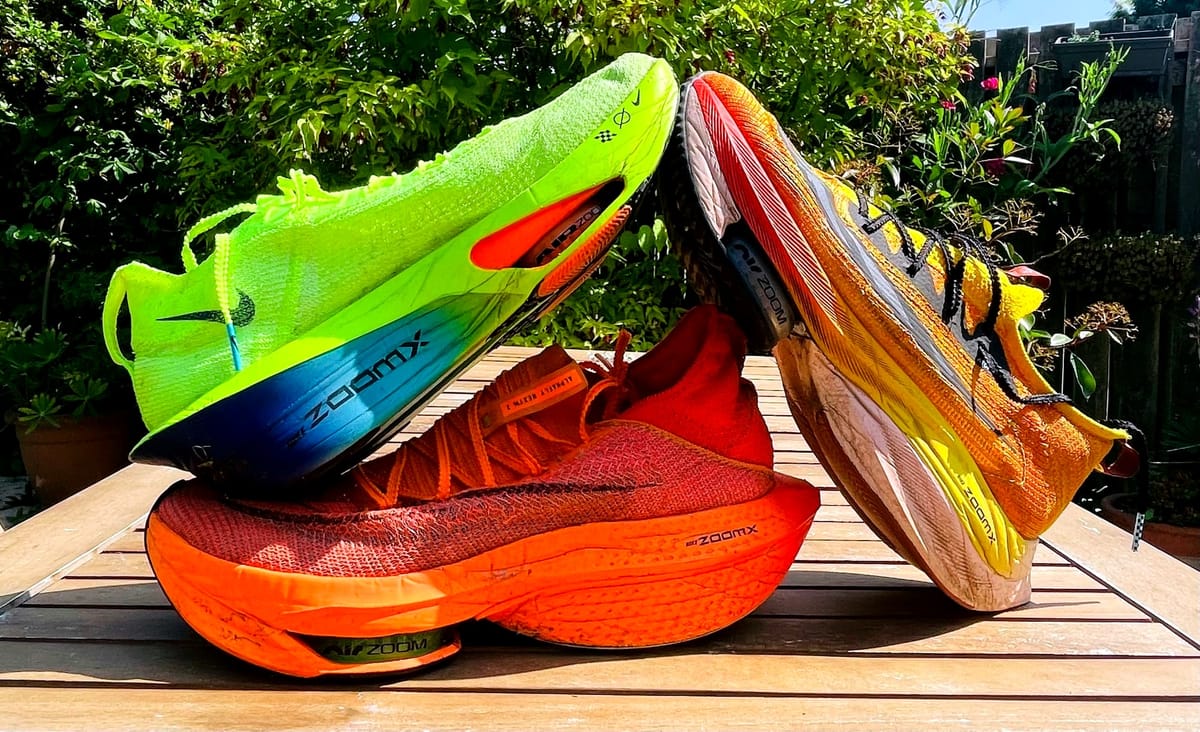Do Alphaflys help you run a sub-3 marathon?
Sub-3 stays with you for life. And in my view, these shoes can help make it happen.

When carbon-plated running shoes first made headlines, it was largely through Eliud Kipchoge and his sub-2 hour marathon attempts. Most of us read about them in the national newspapers. I certainly didn’t imagine, back in the depths of lockdown, that these high-tech racing shoes would become relevant to amateur runners chasing sub-3 hours. The idea of spending over £200 on shoes seemed faintly ridiculous at a time when we weren’t even allowed out for more than an hour a day. But things changed fast.
In summer 2022, having just recovered from my first sub-3 marathon in Brighton that spring, I took the plunge on a discounted pair of Vaporflys. I’d been a loyal Brooks Hyperion Tempo runner and didn’t expect much. But I had a local 10K coming up, and thought I’d test the hype.
I ended up running 37:04 – over 90 seconds faster than my PB. The effort felt similar, if not easier, than previous races. My stride length was longer, my cadence stayed high, and it felt like the ground was giving something more back. I'd never wanted to kiss a pair of shoes more.
From that moment, carbon shoes were part of my race-day mindset.
Soon after, a pair of Alphafly 1s popped up online in my size, and I couldn’t resist. I had the Yorkshire Marathon coming up, and was curious to see what the next level might feel like. These weren’t just plated shoes – they came with pods.
To me, with a high cadence, Alphaflys feel almost like riding a horse. They lock you into a rhythm and subtly increase your stride length. My son calls them “moon boots,” and there’s something in that – as if gravity is slightly less strong when wearing them. The loud slapping sound as they hit the tarmac can sound as if you're riding a horse too.
In Yorkshire, I bounced through the first half, feeling fantastic. Then something changed. I began to feel pain in my leg and a blister forming underfoot. I pushed through and still managed a massive new PB – 2:50:33 – but later discovered one of the forefoot pods had popped, completely deflated. A freak incident, but a real one (I should say the retailer immediately replaced them with a sparkling new pair of Alphafly 2s with no charge, so returns usually aren't an issue).
I don’t blame the shoes, but it’s worth noting: super shoes amplify both your strengths and your form flaws. They need to be ridden with care.
In fact, I later tore a hamstring during a 10K when I began overstriding in a mid-race sparring match. The Alphaflys allowed it. My ego took over. The result was a serious injury. They can change the way you run – and your muscles might not be ready for it.
That said, when used well, Alphaflys are an asset. My 2023 London Marathon PB of 2:49 was run in Alphafly 2s. Heavier and more padded than the original, they’re a little more forgiving, with more protection against popped pods. Alphafly 3s are lighter again, far more comfortable, and the pods are now integrated and shielded. However they squeak a little when new (you’ll sound like you're squashing a mouse for the first few kilometres, but it fades over time).
Will they make you faster? If you’re getting close to sub-3 or beyond, then almost certainly (although I wouldn’t recommend for heel strikers aiming for sub-4). But how much faster is the question.
The science bit
The original Vaporfly study (Hoogkamer et al, 2018) found that carbon-plated shoes could improve running economy by about 4%. More recent tests have confirmed similar results across other brands. That doesn’t directly translate to race time, but a 2:59 marathoner with a 4% efficiency gain might expect to shave a few minutes off – all other things being equal. It’s not a magic bullet, but it is a marginal gain that matters.
They also reduce impact forces and muscle damage, which means faster recovery. Old Alphaflys make excellent tempo or marathon-effort shoes once they’re past their racing prime (I retire mine from A races at around 200km of hard use).
Are they worth it for sub-3 runners?
Absolutely – or at least a carbon-plated shoe is. These are now the norm at the front of every major race – from 5K to marathon. If you’re in the elite start pen and not wearing carbon shoes, you’ll stand out. And you can often guess who the frontrunners are going to be just by looking at their feet.
That said, the shoes won’t do the work for you. They might shave five minutes off your marathon time – not 30. Sub-3 still requires hard training, intelligent pacing and sacrifice.
But when you’ve invested the time, discipline and emotional energy to train for a sub-3 marathon, don’t let a point of principle stop you from using a tool that can genuinely help. If cost is an issue - and you indulge - drop alcohol and takeaways for a month or so. Your fitness will benefit as much as your bank balance — and you may find you are able to buy the shoes.
Alphaflys aren’t for everyone. Some runners prefer other brands. Some feel better in Vaporflys. But if you haven’t tried a pair – and especially if you can get hold of the original AF1s second-hand – I’d encourage you to give them a go.
Sub-3 stays with you for life. And, in my view, these shoes can help make it happen.
Five Things Sub-3 Runners Should Consider Before Racing in Alphaflys
1. They can absolutely help — but only if you’re ready.
Alphaflys improve running economy and reduce impact, but they also exaggerate your form. If you overstride, fatigue early, or lack strength in key muscles, they can make problems worse — and even cause injury.
2. They change your stride mechanics.
Expect longer stride length, higher cadence, and a subtle ‘bounce’ effect — especially if you’re a high-cadence runner. They lock you into rhythm. But that rhythm isn’t always forgiving when you fatigue.
3. They’re fast — but not invincible.
A popped pod in Yorkshire and a hamstring tear in a 10K were reminders: these are high-performance tools, not magic shoes. Used well, they deliver — but don’t let ego or racing instincts override control. They also aren't as built to last as other more mainstream shoes, as short-term performance is the priority.
4. The version matters.
AF1s feel raw and aggressive. AF2s are bulkier but more forgiving. AF3s offer the best blend yet: lighter, more comfortable, and less prone to issues (although less "poppy" than the AF1s). If you’re new to Alphaflys, v3s are a safer start.
5. They’re an investment — but one that lasts.
Yes, they’re expensive. But retired Alphaflys make brilliant tempo or marathon-effort trainers. If you’re chasing sub-3, these shoes aren’t extravagance. They’re equipment — like a carbon bike or wetsuit. You can also often get some decent secondhand deals on Vinted or eBay (although careful of fakes).
Enjoyed this article? Help keep Sub-3 running — support us with a coffee.
To help fund the running of the site, Sub-3 is an Amazon Associate and earns from qualifying purchases. We only recommend gear or kit that has genuinely helped in our own running and that we believe is worth considering.



